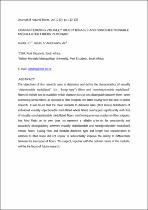 ResearchSpace
ResearchSpace
Characterizing visually objectionable and nonobjectionable medullated fibers in mohair
JavaScript is disabled for your browser. Some features of this site may not work without it.
- ResearchSpace
- →
- Research Publications/Outputs
- →
- Journal Articles
- →
- View Item
| dc.contributor.author |
Hunter, Lawrance

|
|
| dc.contributor.author |
Smuts, S

|
|
| dc.contributor.author |
Botha, Anton F

|
|
| dc.date.accessioned | 2013-08-01T11:57:35Z | |
| dc.date.available | 2013-08-01T11:57:35Z | |
| dc.date.issued | 2013-06 | |
| dc.identifier.citation | Hunter, L, Smuts, S and Botha, A.F. 2013. Characterizing visually objectionable and nonobjectionable medullated fibers in mohair. Journal of natural fibers, vol.10 (2), pp 112-135 | en_US |
| dc.identifier.issn | 1544-0478 | |
| dc.identifier.uri | http://dx.doi.org/10.1080/15440478.2013.763483 | |
| dc.identifier.uri | http://hdl.handle.net/10204/6912 | |
| dc.description | Copyright: 2013 Taylor & Francis. This is an ABSTRACT ONLY. The definitive version is published in the Journal of natural fibers, vol 10(2), pp 112-135 | en_US |
| dc.description.abstract | The objectives of this research were to determine and define the characteristics of visually “objectionable medullated” (i.e., “kemp type”) fibers and “nonobjectionable medullated” fibers in mohair and to establish which characteristic(s) best distinguish between them, when examining whole fibers, as opposed to fiber snippets, the latter having been the case in earlier research. It was found that the mean medulla to diameter ratio (Med Ratio) distribution of individual visually objectionable medullated whole fibers overlapped significantly with that of visually nonobjectionable medullated fibers, confirming previous studies on fiber snippets, that Med Ratio on its own does not represent a reliable criterion for consistently and accurately distinguishing between visually objectionable and nonobjectionable medullated mohair fibers. Taking fiber and medulla diameter, type and length into consideration in addition to Med Ratio did not appear to substantially improve the ability to differentiate between the two types of fibers. This aspect, together with the cellular nature of the medulla, will be the focus of future research. | en_US |
| dc.language.iso | en | en_US |
| dc.publisher | Taylor & Francis | en_US |
| dc.relation.ispartofseries | Worklist;11261 | |
| dc.subject | Mohair | en_US |
| dc.subject | Objectionable fibers | en_US |
| dc.subject | Medullated fiber | en_US |
| dc.subject | Kemp type | en_US |
| dc.subject | Mean medulla to diameter ratio | en_US |
| dc.subject | Med ratio | en_US |
| dc.title | Characterizing visually objectionable and nonobjectionable medullated fibers in mohair | en_US |
| dc.type | Article | en_US |
| dc.identifier.apacitation | Hunter, L., Smuts, S., & Botha, A. F. (2013). Characterizing visually objectionable and nonobjectionable medullated fibers in mohair. http://hdl.handle.net/10204/6912 | en_ZA |
| dc.identifier.chicagocitation | Hunter, Lawrance, S Smuts, and Anton F Botha "Characterizing visually objectionable and nonobjectionable medullated fibers in mohair." (2013) http://hdl.handle.net/10204/6912 | en_ZA |
| dc.identifier.vancouvercitation | Hunter L, Smuts S, Botha AF. Characterizing visually objectionable and nonobjectionable medullated fibers in mohair. 2013; http://hdl.handle.net/10204/6912. | en_ZA |
| dc.identifier.ris | TY - Article AU - Hunter, Lawrance AU - Smuts, S AU - Botha, Anton F AB - The objectives of this research were to determine and define the characteristics of visually “objectionable medullated” (i.e., “kemp type”) fibers and “nonobjectionable medullated” fibers in mohair and to establish which characteristic(s) best distinguish between them, when examining whole fibers, as opposed to fiber snippets, the latter having been the case in earlier research. It was found that the mean medulla to diameter ratio (Med Ratio) distribution of individual visually objectionable medullated whole fibers overlapped significantly with that of visually nonobjectionable medullated fibers, confirming previous studies on fiber snippets, that Med Ratio on its own does not represent a reliable criterion for consistently and accurately distinguishing between visually objectionable and nonobjectionable medullated mohair fibers. Taking fiber and medulla diameter, type and length into consideration in addition to Med Ratio did not appear to substantially improve the ability to differentiate between the two types of fibers. This aspect, together with the cellular nature of the medulla, will be the focus of future research. DA - 2013-06 DB - ResearchSpace DO - 10.1080/15440478.2013.763483 DP - CSIR KW - Mohair KW - Objectionable fibers KW - Medullated fiber KW - Kemp type KW - Mean medulla to diameter ratio KW - Med ratio LK - https://researchspace.csir.co.za PY - 2013 SM - 1544-0478 T1 - Characterizing visually objectionable and nonobjectionable medullated fibers in mohair TI - Characterizing visually objectionable and nonobjectionable medullated fibers in mohair UR - http://hdl.handle.net/10204/6912 ER - | en_ZA |





